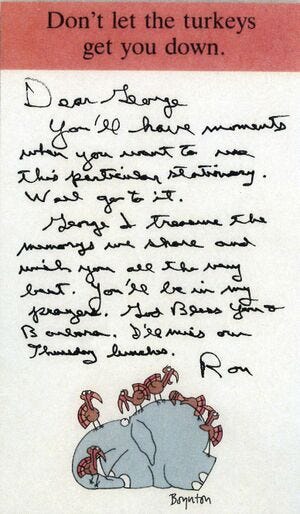Presidential Transition-Type Letters for Your Organization
Communication, as departing US Presidents offer successors, can be helpful
It might be useful for organizations departing leaders to leave supportive, insightful, encouraging letters for their successors. It’s a practice, starting with Ronald Reagan, that US presidents have done for the people who have followed them in office.
“Every four or eight years, as America’s leadership changes hands, an almost invisible ritual takes place behind the closed doors of the Oval Office,” wrote TRT World.
“It’s a rare instance of unfiltered communication between peers, meant to be candid, brief and private. Some presidents take the opportunity to share wisdom, others opt for humor, but each note becomes a small, enduring part of the American tradition.
“The outgoing president leaves a personal letter on the Resolute Desk — an heirloom of American history used by almost every president since 1880 — for the incoming head of state.”
What those presidents have communicated has revealed professionalism, respect for the office, the country and the next leader of the nation.
Reagan was inspired to write to George H.W. Bush, with whom he had developed a friendship during their eight-year White House partnership, Mark Updegrove, president and CEO of the LBJ Foundation, told Darlene Superville, writing at the Associated Press
Reagan “chose a sheet of whimsical stationery illustrated by the cartoonist Sandra Boynton with an elephant — also the Republican Party mascot — surrounded by turkeys and the phrase, ‘Don’t let the turkeys get you down,’” Superville reported.
“You’ll have moments when you want to use this particular stationery. Well, go to it,” Reagan wrote.
The pressure of the office not only comes from the outside, but can also originate from ambitious people on the team.
Reagan had once advised Bush to “stay away from overly confident colleagues who could keep him from achieving his best,” per TRT World.
Bush would later leave a letter for Bill Clinton that was encouraging, honest, a warning and supportive. “I wish you great happiness here,” he wrote. “I never felt the loneliness some Presidents have described.
“There will be very tough times, made even more difficult by criticism you may not think is fair. I’m not a very good one to give advice; but just don’t let the critics discourage you or push you off course.”
The letter’s words resonated deeply with Clinton, showing the power of a departing leader communicating in a way that is helpful to the new one.
"I love that letter," he told ABC News in 2018. "I thought it was vintage George Bush. I thought he meant it, but I also thought he was trying to be a citizen in the highest sense of the word. It was profoundly moving to me personally,” reported Emily Shapiro Clinton saying.
The letters might help calm the expected, natural nerves of the incoming leader and let them know they are not alone in how they might be feeling.
“There’s nothing that can completely prepare you for the job of being President…,” Barack Obama said in 2016. “You know, that first day after…they walk you into the Oval Office, then everybody leaves, and you’re thinking, ‘Oh man, now what?!’
The letters reflect the lessons learned from their experiences but also healthy reminders to empower the new president.
“The burdens you now shoulder are great but often exaggerated,” Clinton to the younger Bush. “The sheer joy of doing what you believe is right is inexpressible.”
Bush, in turn, did the same for Obama.
“Very few have had the honor of knowing the responsibility you now feel,” he wrote. “Very few know the excitement of the moment and challenges you will face.
“There will be trying moments. The critics will rage. Your ‘friends’ will disappoint you.”
Obama communicated to Donald Trump to focus on the biggest picture.
“… we are just temporary occupants of this office,” Obama wrote.
He also reminded Trump to protect his peace of mind through a balance in living and time with his closest relationships.
“And finally, take time, in the rush of events and responsibilities, for friends and family,” Obama wrote. “They’ll get you through the inevitable rough patches.”
Transition for Organizations Incoming Leadership
“Exiting leaders have valuable knowledge about the organization’s culture and unwritten rules of the workplace. Often, this knowledge is undocumented and can be lost when a leader leaves the workplace,” says Melissa Nelson, the chief talent officer at law firm, Levenfeld Pearlstein and a professional with a master’s degree in leadership and organizational development.
“A transition letter can help bridge the gap and maintain consistency of the role within the organization. Additionally, a transition letter can increase productivity by enabling the new leader to focus on their core responsibilities without getting side-tracked learning these cultural norms.”
There’s another benefit that she believes is even more important. “A transition letter can help the new leader feel welcome in the organization,” Nelson says.
Transition letters can not only be helpful words for new leaders, they can reflect well on the leader writing them if they are done well.
“It shows a positive attitude, high level of professionalism, loyalty and sincerity of the departing leader to care enough about the organization and its cause,” says Iqbal Ahmad, director at the Britannia School of Academics and professional involved in leadership training for the last 15 years.
“This, in turn, will have a positive effect on the reputation and career prospects of the departing person.”
The recipient is likely to value the thoughtfulness and wisdom of the message when that communication is selfless and expresses confidence.
“For the incoming leader, it will appear to be a very warm and helpful gesture, triggering the kind of passionate start that can be expected from a new leader joining the organization,” Ahmad states.
“There is no person better positioned to give the level of insights into the challenges being faced by the organization or the opportunities at hand than the departing leader.”
He is an advocate for this type of helpful communication becoming a norm.
“From the organization’s point of view, this will be a very positive tradition that will set the tone for the entire team — promoting a culture of teamwork and collaboration,” Ahmad suggest.
“After all, if a departing person is able to show this level of care for an incoming person, then why can’t all the existing employees support each other for the effective fulfillment of their respective roles?”
How valuable such a message can become is dependent on the contents.
“I believe that receiving a transition letter can be a great benefit if it offers the new leader a constructive perspective, including lessons learned, challenges faced and some words of encouragement,” says Michelle Enjoli, a career development coach and speaker for professionals and leaders.
“Additionally, an invitation to reach out for future questions or support would be a great bonus.”

Potential Downsides
There may be initial interpretations and feelings experienced by the recipient.
“Because each leader has their own leadership style and personality, there is a small risk that what one leader deems helpful and encouraging might not be perceived as such by the subsequent leader,” Nelson says. “But when transition letters maintain a high degree of professionalism, this risk is small.”
Ahmad thought deeply about it for a moment.
“Though it’s hard to spot a downside, one possible risk is the bias that the insights of the departing leader might create in the mind of the new leader,” he says.
“In the absence of such a note, the new leader is likely to carry out their own due diligence to gauge where the organization stands in terms of its strengths, weaknesses, opportunities and threats.
“Therefore, a note from the departing leader will deprive the organization of such a fresh and independent assessment of the situation.”
While it may be rare, there could be conflict from the past or hardened views about leadership and what the role is or should be between the two people (and possibly the organization) that may not sit well.
“Similarly, the note might be taken very differently from its intended purpose, especially when the two leaders have found themselves at odds in the past or have very different perspectives about various situations,” Ahmad says.
“What is perceived as a threat by a departing leader might be seen as an opportunity to change and adapt. For the same reason, the departing leader might be too careful to leave a note that truly reflects their understanding of where the organization stands.”
Best Advisory for the Practice of Transition Letters
“To be effective, transition letters should be professional and encouraging,” Nelson advises. “They should welcome the new leader into the role and express confidence in their ability to be successful in the role. Reminders about critical cultural norms or organizational priorities may also be helpful.”
Enjoli believes it works best when it becomes an ongoing duty to communicate.
“… the employer and the exiting leader would need to be committed to continuing it,” she says. “Incorporating the transition letter as part of the exit plan could further enhance its effectiveness.”
“The practice is most likely to work in an organization that highly values integrity and transparency over political correctness,” Ahmad asserts.
“The note should not be about making some polite statements with wishful comments… The note should be able to make an impact on the strategic direction of the company, of course on the assumption that the new leader takes the content of the note into consideration.”
To advertise, sponsor a section of the newsletter or discuss your affiliate marketing program, contact CI.
Recent Articles
AI Apologies: a Tool and a Risk
Learning to ‘Give Parts of You’ to Win
Knowing Your Leadership Non-Negotiables
‘Prickly Egos’ and Your Response
Instead of Pointing the Finger, We Can…
The Smart, Brave ‘Idiot’ in Meetings
Successful Leaders’ Stage Fright — And Overcoming It












